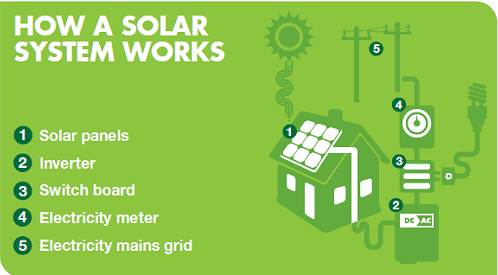While the technology behind solar energy may seem complex, when broken down, how solar power works is easy to understand – particularly in a grid connect scenario as it only requires a few components installed in your home or business.

- The sun shines on the solar panels generating DC electricity
- The DC electricity is fed into a solar inverter that converts it to 240V 50Hz AC electricity.
- The 240V AC electricity is used to power appliances in your home.
- Surplus electricity is fed back into the main grid.
Whenever the sun shines (and even in overcast weather), the solar cells generate electricity. The grid connect inverter converts the DC electricity produced by the solar panels into 240V AC electricity, which can then be used by the property/household.
If a grid connect system is producing more power than is being consumed, the surplus is fed into the mains power grid. Some electricity companies will meter the electricity fed into the grid by your system and provide a credit on your bill.
When the solar cells are not producing power, for example at night, your power is supplied by the mains power grid as usual. The energy retailer charges the usual rate for the power used.
As all of the components in a grid connect system have no moving parts, you can expect a long and hassle free life from your solar power system! Generous government renewable energy rebates mean you can also save thousands on a grid connect system for a limited time!
Installing a grid connect solar system
Most customers choose a roof mounted solar system. For most of Australia, the modules should be installed facing north in order to take full advantage of the sun; however a west facing installation may also be desirable.
Our accredited grid connect installers will aim to install the modules at an angle which ensures that the glass face of the modules is positioned at 90 degrees to the sun for most of the day. As an example, in Sydney this angle would be approximately 30-40 degrees to the horizontal. Standard Australian roofs usually have an angle of elevation of ~22 degrees, which is acceptable. This provides a close approximation to the position in which a solar array produces its maximum output. For installations on flat roofs an elevated array frame allows the solar modules to be installed at an angle of elevation of approximately 30 degrees from the horizontal.
What’s the right size system? How much will it cost?
As everyone’s needs are different and the generation potential of solar power differs from place to place , a quick way is to use our free solar quote system to determine the cost and estimated benefit of an installation. You can also learn more about solar power system sizing here.

If you’d prefer to speak directly to an expert, contact our team of friendly consultants for free, no-obligation advice.
HOW A GRID CONNECTED SOLAR POWER SYSTEM WORKS
![HOW A GRID CONNECTED SOLAR POWER SYSTEM WORKS]() Reviewed by mevasan
on
8:32 PM
Rating:
Reviewed by mevasan
on
8:32 PM
Rating:

No comments: